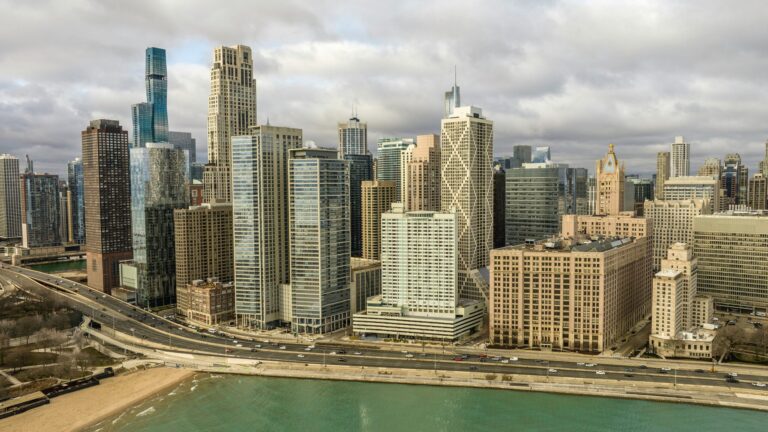A New Wave of Commercial Property Investment in Chicago
The commercial real estate industry has long been a cornerstone of the U.S. economy, with investors and developers continuously seeking new opportunities to reshape urban landscapes. On June 15, 2023, the commercial real estate community converged in Chicago for the Midwest Commercial Property Expo, a gathering that attracted over 1,500 investors, brokers, developers, and industry professionals. The event, rich in panel discussions, networking sessions, and industry insights, was marked by one standout moment: the highly anticipated keynote address by renowned real estate investor, Robert “Bob” Grayson.
Grayson, known for his transformative projects across the country, announced plans for an ambitious $500 million investment into a portfolio of aging commercial properties in Chicago’s West Loop. The announcement sent ripples of excitement throughout the crowd, highlighting the shift in the commercial property market toward adaptive reuse, a trend that has been gaining momentum as the industry seeks to meet new demands for mixed-use spaces and modern amenities.
Repositioning Commercial Buildings for a Post-Pandemic Era
Grayson’s plan focuses on the renovation of underperforming office buildings in the West Loop area. Rather than simply renovating these properties for traditional office space, Grayson aims to create mixed-use developments that blend retail, office, and residential units. This approach is designed to address the evolving needs of businesses and consumers, particularly as remote work and flexible office environments have redefined how companies and their employees use commercial spaces.
As businesses reassess their office requirements post-pandemic, there is a growing demand for spaces that combine different uses in a single location, offering convenience and adaptability. Grayson’s vision is to create dynamic environments where professionals can work, live, and shop all within close proximity. The planned developments will also incorporate cutting-edge technology and high-end amenities, including smart building systems, energy-efficient designs, and wellness-focused features.
In his keynote address, Grayson emphasized that these properties would not only serve the immediate needs of the modern workforce but also add long-term value to the neighborhood and the broader commercial property market. He believes that the integration of mixed-use spaces into aging buildings, particularly in urban areas, will help revitalize communities and stimulate local economies.
Overcoming Challenges in a Changing Market
Despite the optimism surrounding the project, Grayson did not shy away from discussing the challenges his team faced in bringing this vision to life. One of the most significant obstacles was navigating Chicago’s complex zoning laws, which required months of negotiation with local government officials and various stakeholders. Zoning regulations, particularly in areas designated for office use, often pose significant hurdles when repurposing properties for mixed-use development.
Another major hurdle for Grayson’s team was securing financing. The banking sector remains cautious in the wake of the economic uncertainty caused by the COVID-19 pandemic, with many lenders hesitant to back large-scale redevelopment projects. However, Grayson’s firm, known for successfully executing large-scale projects in the past, was able to navigate these challenges through careful planning, stakeholder engagement, and by securing strategic partnerships with institutional investors.
In addition to financing, the team faced logistical hurdles related to global supply chain disruptions, which have made sourcing construction materials increasingly difficult. The project’s scale and complexity meant that the team needed to carefully manage both the sourcing of materials and the timelines to ensure the successful completion of the renovation work.
The Future of Commercial Real Estate in Urban Centers
Grayson’s announcement signals a broader shift in the commercial real estate market, especially in urban centers like Chicago. The concept of adaptive reuse—where existing buildings are repurposed for new uses—has gained traction in recent years. This trend is expected to continue, particularly as cities work to recover from the economic impacts of the pandemic and adapt to new ways of living and working.
For Chicago, Grayson’s $500 million investment marks a pivotal moment for the city’s West Loop neighborhood, an area already known for its vibrant culture and growing business hub. The project is set to set a new benchmark for urban redevelopment, offering a model for future adaptive reuse efforts across the country.
As the commercial real estate market continues to evolve in response to new challenges and opportunities, it is clear that adaptive reuse will be a key strategy for revitalizing underperforming buildings, improving the urban landscape, and meeting the demands of a post-pandemic world. Grayson’s project is just the beginning, and it will likely serve as an inspiration for other investors and developers looking to make their mark on the ever-changing commercial property sector.
In the coming years, we may see an influx of similar projects that push the boundaries of what commercial real estate can be, further blending residential, retail, and office spaces to create more integrated and dynamic urban environments. As cities continue to adapt and recover, the industry will undoubtedly play a central role in shaping the future of our urban spaces.
